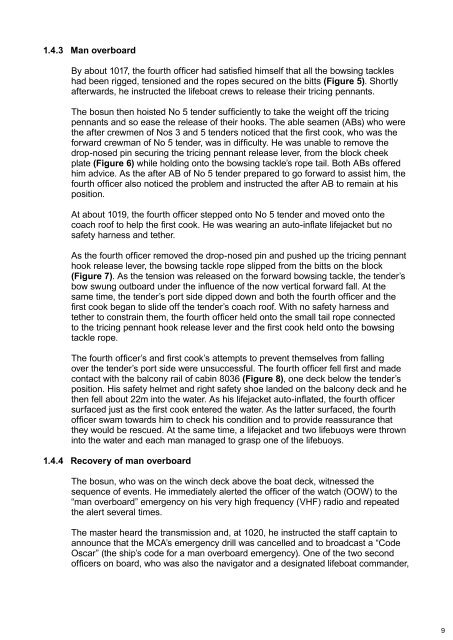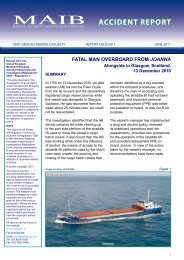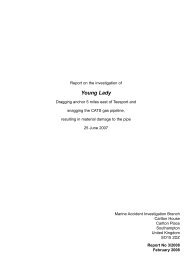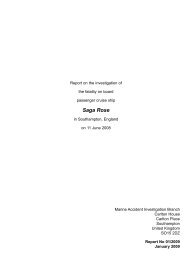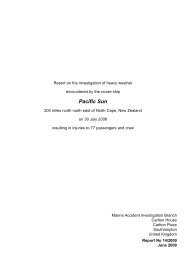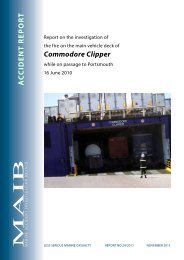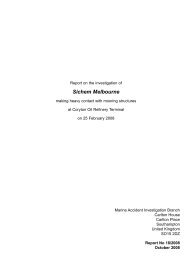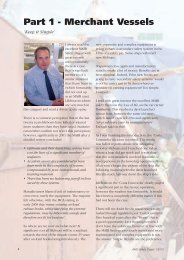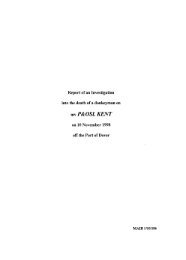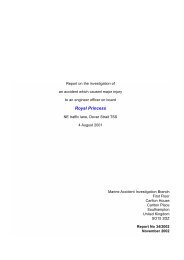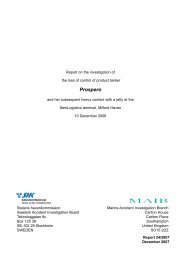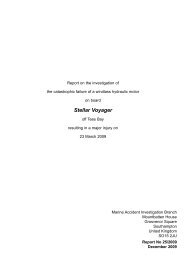SECTION 4 - Marine Accident Investigation Branch
SECTION 4 - Marine Accident Investigation Branch
SECTION 4 - Marine Accident Investigation Branch
Create successful ePaper yourself
Turn your PDF publications into a flip-book with our unique Google optimized e-Paper software.
1.4.3 Man overboard<br />
By about 1017, the fourth officer had satisfied himself that all the bowsing tackles<br />
had been rigged, tensioned and the ropes secured on the bitts (Figure 5). Shortly<br />
afterwards, he instructed the lifeboat crews to release their tricing pennants.<br />
The bosun then hoisted No 5 tender sufficiently to take the weight off the tricing<br />
pennants and so ease the release of their hooks. The able seamen (ABs) who were<br />
the after crewmen of Nos 3 and 5 tenders noticed that the first cook, who was the<br />
forward crewman of No 5 tender, was in difficulty. He was unable to remove the<br />
drop-nosed pin securing the tricing pennant release lever, from the block cheek<br />
plate (Figure 6) while holding onto the bowsing tackle’s rope tail. Both ABs offered<br />
him advice. As the after AB of No 5 tender prepared to go forward to assist him, the<br />
fourth officer also noticed the problem and instructed the after AB to remain at his<br />
position.<br />
At about 1019, the fourth officer stepped onto No 5 tender and moved onto the<br />
coach roof to help the first cook. He was wearing an auto-inflate lifejacket but no<br />
safety harness and tether.<br />
As the fourth officer removed the drop-nosed pin and pushed up the tricing pennant<br />
hook release lever, the bowsing tackle rope slipped from the bitts on the block<br />
(Figure 7). As the tension was released on the forward bowsing tackle, the tender’s<br />
bow swung outboard under the influence of the now vertical forward fall. At the<br />
same time, the tender’s port side dipped down and both the fourth officer and the<br />
first cook began to slide off the tender’s coach roof. With no safety harness and<br />
tether to constrain them, the fourth officer held onto the small tail rope connected<br />
to the tricing pennant hook release lever and the first cook held onto the bowsing<br />
tackle rope.<br />
The fourth officer’s and first cook’s attempts to prevent themselves from falling<br />
over the tender’s port side were unsuccessful. The fourth officer fell first and made<br />
contact with the balcony rail of cabin 8036 (Figure 8), one deck below the tender’s<br />
position. His safety helmet and right safety shoe landed on the balcony deck and he<br />
then fell about 22m into the water. As his lifejacket auto-inflated, the fourth officer<br />
surfaced just as the first cook entered the water. As the latter surfaced, the fourth<br />
officer swam towards him to check his condition and to provide reassurance that<br />
they would be rescued. At the same time, a lifejacket and two lifebuoys were thrown<br />
into the water and each man managed to grasp one of the lifebuoys.<br />
1.4.4 Recovery of man overboard<br />
The bosun, who was on the winch deck above the boat deck, witnessed the<br />
sequence of events. He immediately alerted the officer of the watch (OOW) to the<br />
“man overboard” emergency on his very high frequency (VHF) radio and repeated<br />
the alert several times.<br />
The master heard the transmission and, at 1020, he instructed the staff captain to<br />
announce that the MCA’s emergency drill was cancelled and to broadcast a “Code<br />
Oscar” (the ship’s code for a man overboard emergency). One of the two second<br />
officers on board, who was also the navigator and a designated lifeboat commander,<br />
9


